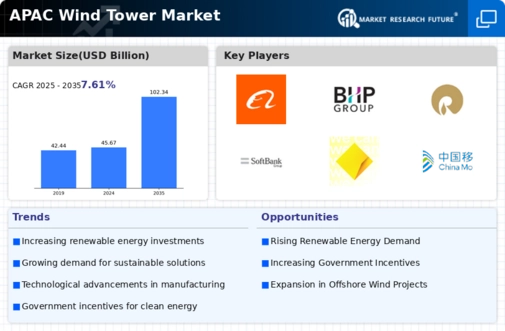February 2022: Tata Power and RWE, a German electricity generating company, forged a partnership to explore opportunities for jointly developing Wind Tower power plants in India
December 2022: TagEnergy and Vestas announced a collaboration to provide Engineering Procurement and Construction (EPC) services for the initial phase of the Golden Plains Wind Power Plant, a 756-megawatt project located in Victoria, Australia.
In October 2024, an MoU was recorded between Dutch companies TWD and IX Renewables as a response to expanding their offshore wind efforts in the APAC region. IX Renewables will be mainly responsible for Offshore wind development management, while TWD will offer engineering services such as method engineering and equipment design. The aim of the collaboration is to enhance project delivery from inception to operation with special attention to the growth markets of Taiwan and Japan, both of which are rapidly expanding in the region.
In November 2024, At the APAC Wind Energy Summit, Corio Generation Corporation (Korea) and Equinor Renewables (Norway) reiterated their commitments to further develop offshore wind energy in these regions. These companies are actively looking for local partners in South Korea, Japan and Taiwan, which enjoy favorable decarbonization policies as well as advantageous seashore conditions to tap into.
In November 2024, Ocean Winds partnered with Hyundai Steel to strengthen their partnership aimed at promoting South Korean offshore wind projects. This partnership will boost the country's aggressive offshore wind energy growth initiatives underpinned by Hyundai Steel's manufacturing capacity and Ocean Winds' offshore experience.
Moreover, the company entered the offshore wind market in December 2023, when CS Wind, a company that manufactures a substantial number of wind towers, acquired a significant presence within the offshore wind market. The acquisition was a landmark event because CS Wind was able to expand its operations into the greater global wind market, strengthening its offshore wind tower niche further. This trend underscores the escalatory dynamics of the offshore wind turbine projects in the APAC region, especially since China and other regional markets Taiwan, Vietnam, and South Korea are still expanding their renewable energy potential.
In October 2024, Siemens Gamesa, a significant entity in wind technology, commenced a move to the South Korean market to partake in the development of offshore wind projects in the country. The construction of the company's wind turbine blades production facility in Incheon is expected to enhance offshore wind capacity goals of 14.3GW by 2030

















Leave a Comment